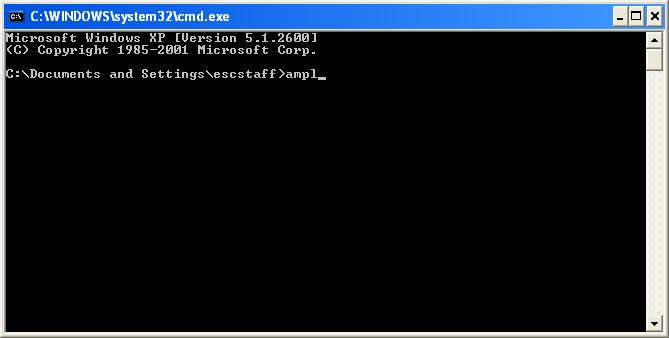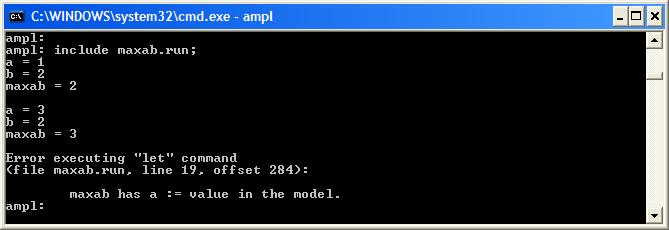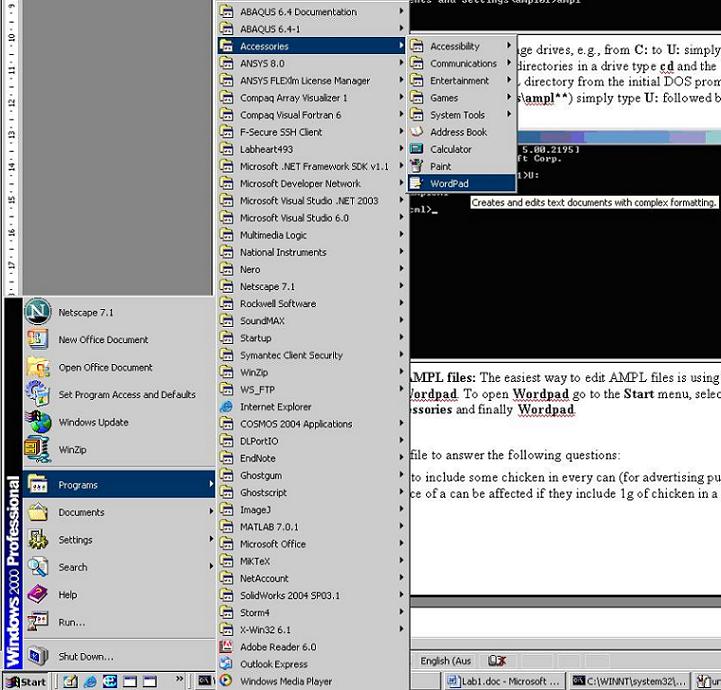
Difference: AMPLProcess (4 vs. 5)
Revision 52008-02-27 - MichaelOSullivan
| Line: 1 to 1 | ||||||||
|---|---|---|---|---|---|---|---|---|
| ||||||||
| Added: | ||||||||
| > > | <-- Ready to Review --> | |||||||
The AMPL Process | ||||||||
| Line: 15 to 16 | ||||||||
To start AMPL in Windows you simply start a command line application and type ampl. | ||||||||
| Changed: | ||||||||
| < < | src="ampl.jpg" | |||||||
| > > |  | |||||||
| You will then be able to enter AMPL commands at the AMPL prompt. | ||||||||
| Changed: | ||||||||
| < < | src="ampl_examples.jpg" | |||||||
| > > |  | |||||||
| Return to top | ||||||||
| Line: 49 to 50 | ||||||||
The AMPL model is input after switching to the (default) model environment, by typing model; and then using the include command to import the model file, or else typing in the commands for the AMPL model directly at the ampl: prompt. | ||||||||
| Changed: | ||||||||
| < < | src="model_include.jpg" | |||||||
| > > |  | |||||||
Alternatively, you can type model <filename>.mod;. | ||||||||
| Changed: | ||||||||
| < < | src="model_file.jpg" | |||||||
| > > |  | |||||||
| Return to top | ||||||||
| Line: 61 to 62 | ||||||||
All data and values specific to the problem instance you are solving are separated from the model formulation when using AMPL. This is enforced by the method used to input the problem details into AMPL - the model formulation is entered in the model environment, the problem specific data is entered in the data environment. To switch from the model environment to the data environment one types data; at the AMPL prompt ampl: (and switches back to the model environment by typing model;). | ||||||||
| Changed: | ||||||||
| < < | src="model_data.jpg" | |||||||
| > > |  | |||||||
As with entering the model formulation, it is common to store the data for a specific problem in a data file (<filename>.dat). This data is then imported while in data mode by using the include command, followed by the filename and a semicolon (or by typing the AMPL commands in directly). | ||||||||
| Changed: | ||||||||
| < < | src="data_include.jpg" | |||||||
| > > |  | |||||||
Again, one can use the alternative method of typing data <filename>.dat (which does not require a switch from the model environment). | ||||||||
| Changed: | ||||||||
| < < | src="data_file.jpg" | |||||||
| > > |  | |||||||
| Return to top | ||||||||
| Line: 86 to 87 | ||||||||
and you run this file using the include command. | ||||||||
| Changed: | ||||||||
| < < | src="script_file.jpg" | |||||||
| > > |  | |||||||
Setting Data Dynamically | ||||||||
| Line: 112 to 113 | ||||||||
| let maxab := 4; # Syntax error, parameter defined by an expression display a, b, maxab; | ||||||||
| Changed: | ||||||||
| < < | src="dynamic_error.jpg" | |||||||
| > > |
 | |||||||
The previous example also showed how to use both the model and data environments in the same script file. Furthermore, rather than using model; to enter the model environment (and leave the data environment), it jumps from the data environment to the model environment by using a command that is not valid in the data environment (the display command). | ||||||||
| Line: 124 to 126 | ||||||||
| The easiest way to edit AMPL files is using a text editor such as Wordpad. To open Wordpad go to the start menu, select Programs, then Accessories and finally Wordpad | ||||||||
| Changed: | ||||||||
| < < | src="run_wordpad.jpg" | |||||||
| > > |  | |||||||
| When you have finished editing, save the file in the appropriate directory. Be sure to save your file as a basic text file *NOT* in Rich Text Format. | ||||||||
| Changed: | ||||||||
| < < | src="save_ampl.jpg" | |||||||
| > > |  | |||||||
Running AMPL files | ||||||||
| Line: 136 to 139 | ||||||||
| ||||||||
| Changed: | ||||||||
| < < |
| |||||||
| > > |
| |||||||
| Return to top -- MichaelOSullivan - 25 Feb 2008 | ||||||||
| Deleted: | ||||||||
| < < |
| |||||||
| ||||||||
View topic | History: r10 < r9 < r8 < r7 | More topic actions...
Ideas, requests, problems regarding TWiki? Send feedback